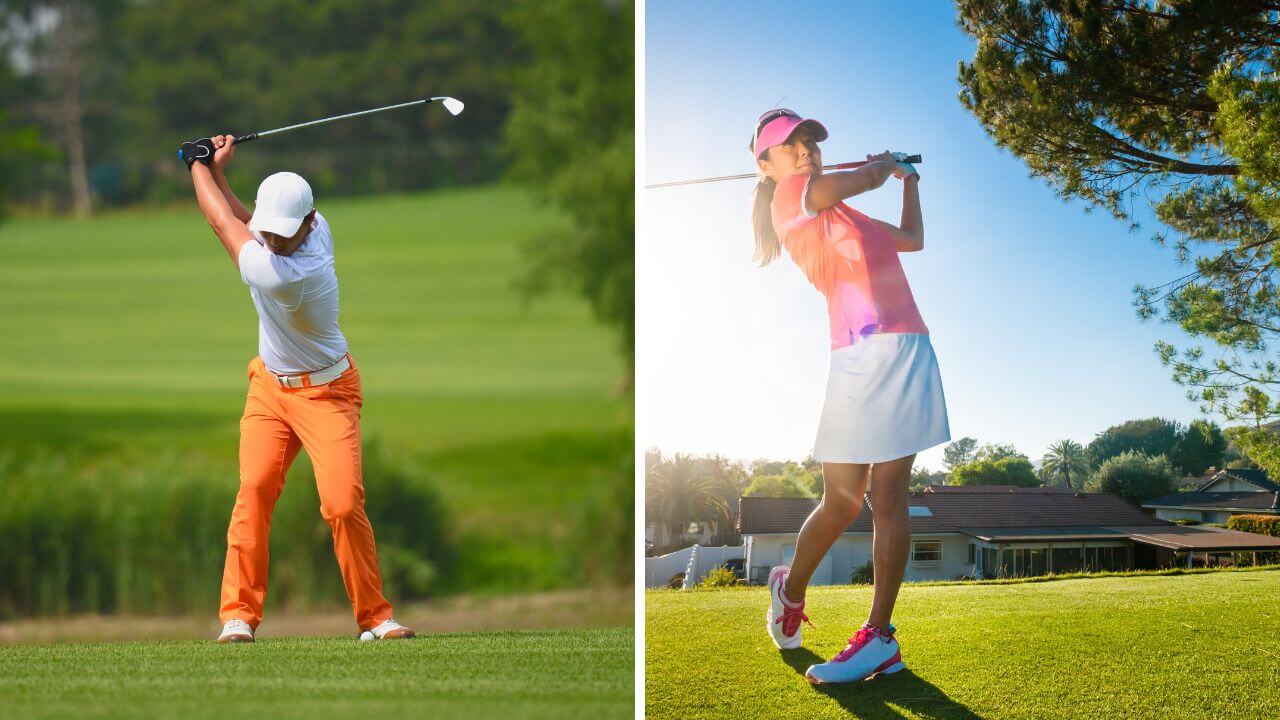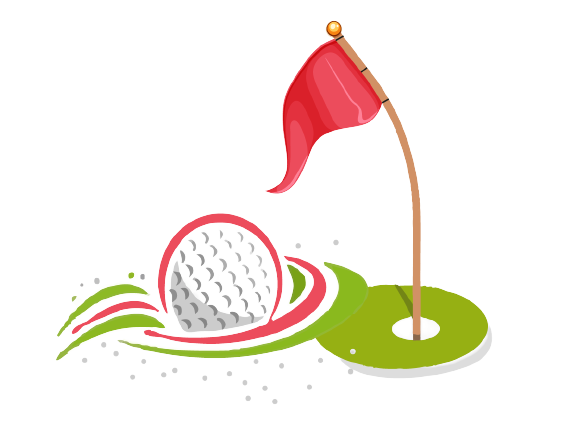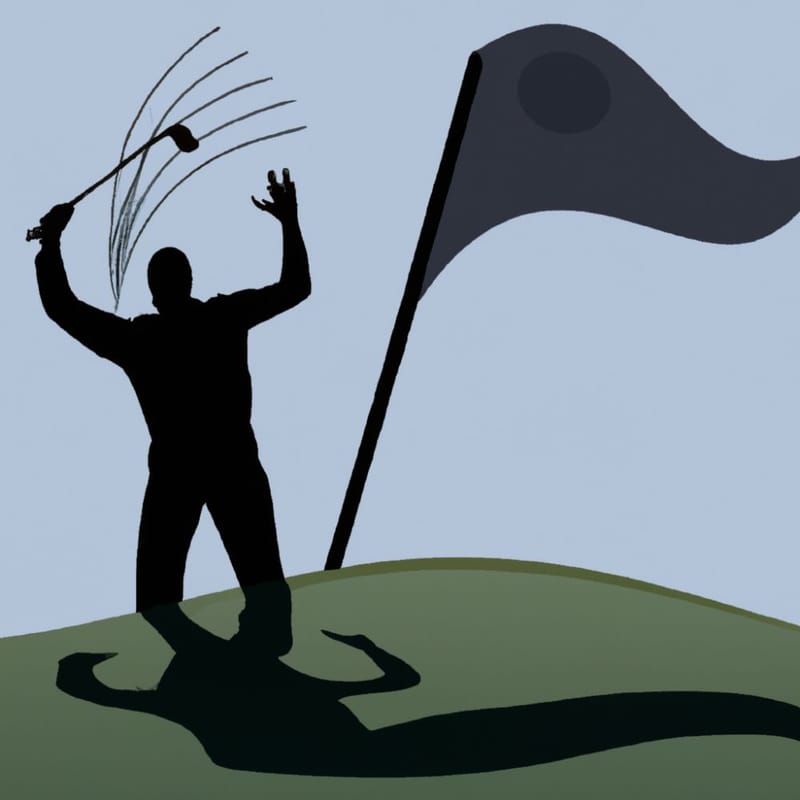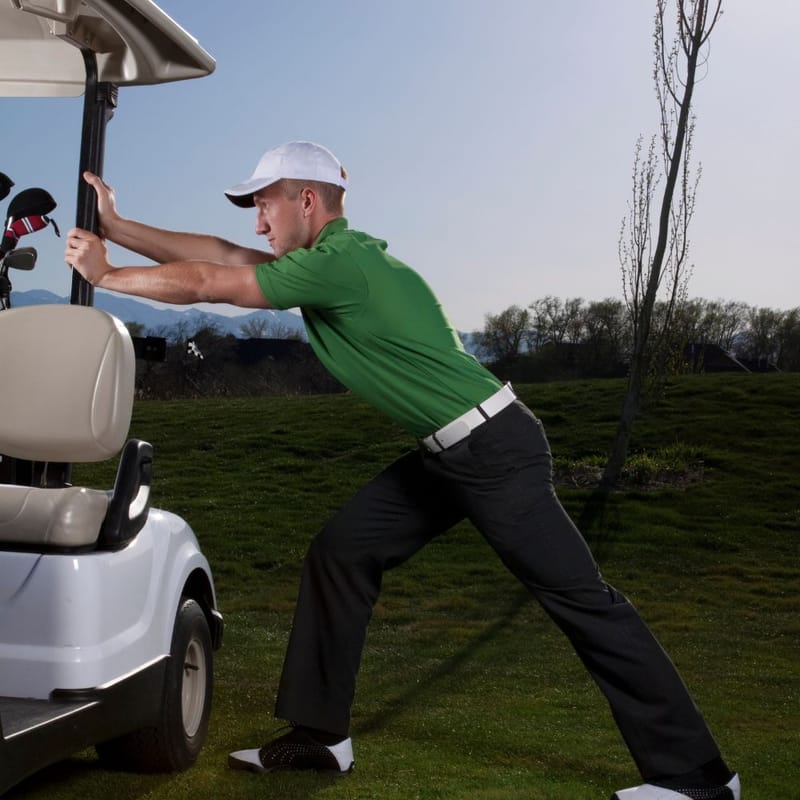Content Summary
This is a unique and fun approach to hitting the golf ball that requires fewer moving parts than the traditional two-handed swing.
It can be a great option for those who are new to the game or those who are looking to simplify their swing mechanics and increase their power.
However, it comes with its own set of pros and cons, so it's important to understand these before diving in.
Let's take a closer look at the one handed golf swing:
Definition of a one-handed golf swing
The one hand golf swing, also known as the power grip, is the alternative to a two-handed golf swing. Primarily used by recreational golfers and professionals alike, a one-handed golf swing puts more emphasis on power.
The one-handed golf swing is similar to the traditional two-handed grip, except that only your dominant hand is placed on the club. When executing this type of swing, you should also keep your wrist straight and almost perpendicular to the ground and hold your club firmly without needing to death grip it.
Your dominant hand is in control during this type of swing. A correctly executed one-handed shot will produce high levels of momentum which gives added distance for your shot.
Therefore, it’s important for players using this technique to make sure they use proper form in order maximize accuracy as well as distance with each shot.
Benefits of a one-handed golf swing
The one-handed golf swing is a great way for golfers to improve their form and acquire more power and distance in their swings.
By utilizing one arm instead of two, you can gain greater control over your swing and hit the ball with greater accuracy.
Additionally, a single-armed golf swing can help keep your body aligned correctly so that you can use your full power when you make contact with the ball.
There are several distinct benefits to using a one-handed golf swing:
- It helps develop good muscle memory.
- It keeps the body physically aligned throughout the entire motion of the swing.
- It simplifies how a golfer positions their arms when making contact with the ball.
- By using only one arm, it helps reduce fatigue while increasing accuracy.
- It helps create smoother swings by reducing wrist action and twisting of the torso.
- It can increase clubhead speed and distance off of every shot.
By taking advantage of these benefits, golfers can create smoother and more accurate swings which will incrementally improve overall scores.
With regular practice and patience, any golfer looking to up their game should be able to successfully master the single-arm drill for a powerful and consistent turn on each shot.
Equipment
What clubs to use
Fundamentally, any club within the set can be used in a one-handed swing, however some may be more effective than others.
The best clubs to use when learning how to do a one-handed golf swing are the mid and short irons, since they allow you to hit shorter shots with a greater chance of accuracy. As your strength and skill increase, you can move to a hybrid or fairway wood as well.
Generally speaking, practice will help you determine which clubs are more comfortable for you. It is important that when learning the one-handed golf swing, you take into account your individual body mechanics and select clubs that feel natural for your size and movement patterns.
What type of golf ball to use
It is important to note that the type of golf ball used has no effect on how you swing your club. Some balls provide higher trajectory and more spin, while others provide fewer spins and straighter shots. It also depends on the golfer's personal preference.
Here is a breakdown of some common varieties of balls:
- Tour Category: Suitable for professional players due to their low-to-mid spin control and low trajectory
- Distance Category: Designed to assist mid to high handicap players in obtaining maximum distance from each shot
- Soft Feel Category: Designed for maximum distance but with softer compression off the tee
- Multi-piece/Multi-layer Category: Consistently able to produce high launch angles and higher spin rates off the tee
- Surlyn® Based Golf Ball: Will generally result in much less spin due to its simplified construction
Technique
The one-handed golf swing is a technique used by golfers who are missing a hand or one of their extremities. Although it is a challenging technique to master, with the correct methods and practice, it can be done. The rules and regulations for one-handed golf swings are laid out by the USGA, so it is important to follow these regulations when attempting a successful one-handed swing.
Let's discuss the technique and practice needed to perfect this swing:
Grip
One of the primary components of a successful one-handed golf swing is your grip. To ensure proper leverage and swing consistency, you'll need to establish an ideal grip with the hand you will be using.
Grab the club so the bottom meaty part of your palm rests on the top of the clubs grip. This is the same as you would hold the club with a two handed grip with your dominant hand.
Posture
Maintaining proper posture during the golf swing is one of the most important elements to achieving success and preventing injury.
Good posture not only reduces force on your joints, muscles, and other soft tissue structures but also affects your biomechanics and coordination patterns.
Regardless of what you’re doing, you want to maintain a neutral alignment from head to toe with your weight evenly distributed over both feet. This means that you want to avoid over-arching or slouching in your spine.
Takeaway
The takeaway is the initial phase of any swing, and it refers to the moment your club starts moving away from the ball. It’s important to maintain proper posture throughout the takeaway in order to achieve a successful one-handed golf swing.
Start with your feet shoulder width apart, knees slightly bent and your hips straight in line with your feet and shoulders facing towards your intended target line.
Start making slow elongated swings back away from the ball, gradually increasing speed during this phase, with minimal arm bend all while keeping everything in line and maintaining posture. Make sure to:
Rotate your upper body around your core causing the dominant shoulder to move underneath the opposite one.
Backswing
A well-executed one-handed golf swing starts by setting up for the backswing. Begin with your dominant hand on the club. Position your feet slightly wider than hip-width apart and point them in line with your shoulders and target line.
As you initiate the backswing, allow your arm to bend at the elbow and your wrist to cock . Take a few practice swings to ensure good balance.
Downswing
The downswing is one of the most important parts of the golf swing. It begins with the lower body and ends with the clubface striking the ball. As the golfer moves through the downswing, it’s important to remain stable, keeping your body movement balanced and efficient throughout.
The ideal downswing should be smooth and in tempo, so each movement complements each other rather than fight against one another. At several points throughout, starting from the hips all the way to impact, various checkpoints should be present to ensure you’re swinging in an optimal fashion. These checkpoints can be:
- Full shoulder turn and hip rotation during takeaway
- Early wrist cock during transition
- Proper hip slide during backswing
- Squaring up of arms and clubface in relation to target at impact
- Maintaining balance throughout swing
Follow-through
The follow-through is the completing motion of the one handed golf swing and is used to develop power in your shot. While executing a proper follow-through, it is important to keep your wrists cocked until impact and then release them into the ball. This releases energy into the ball and allows you to hit it further down the fairway.
Additionally, make sure that your weight shifts from the back foot towards the front foot throughout your swing. This shift in weight will ensure proper power transfer between you and your club, therefore transferring maximum amounts of power and momentum into your shots.
Finally, when following through make sure to finish with a balanced stance by swinging through with your arm outstretched but keeping a slight bend in the elbow; this will ensure accurate control during each swing. Furthermore, as you are finishing in your follow through keep an eye on where you want to send the ball–this will help you deliver each shot accurately for better results on the fairway.
Drills
Learning the one-handed golf swing can be a great way to improve your golf game. To help you get better at performing this swing, it's important to practice doing the right drills. Drills can help you work on your balance, rhythm and timing, and also fine-tune your technique.
Weight shift drill
Weight shift drill is designed to help a golfer make sure they are making a proper weight shift during their one handed golf swing. To perform this drill, start by standing in your normal address position, with your nondominant hand (if appropriate) tucked behind your back. Make a backswing and hit an imaginary golf ball as you would if you were hitting the ball with one hand. The goal of this drill is for the golfer to focus on pushing their weight onto their opposite side from the start of swing.
This will ensure that all of the power moves through the body during the swing, rather than having more power relying on extra arm strength. Once comfortable with this movement, it should be easy to transfer into a real one handed golf swing so that it becomes second nature during the game.
Impact drill
One of the most effective and important drills for performing a one handed golf swing is the impact drill. This drill helps to create an "impact bag" on the club handle to allow for better contact with the ball at impact.
To do this drill, stand tall and hold the golf club at address with your dominant hand, and make sure your arm is completely straight. Next, take a practice swing—it should be a full swing movement. At the top of your backswing, quickly transition into your downswing while focusing on keeping your arm and wrist in sync.
When you reach impact position, quickly stop in that spot—this should create an impact bag feeling as if you are hitting into a heavy bag or cushioning material with your hand. Once your arm reaches this point, pause in that position before transitioning into a full follow through motion and finishing in balance with control.
Practicing this drill will help ingrain correct movement mechanics that will lead to better ball striking during play. This drill is good for 2 handed golfers as well.
Alignment drill
The alignment drill is designed to help golfers become acutely aware of their target line when setting up for the golf swing. By ensuring that an imaginary ‘line’ between the ball and club is aligned with the intended target, the golfer can take a more accurate approach to aiming each shot.
To execute this drill, set an alignment stick in the ground in front of the ball. Visualize two lines that form a perpendicular path from the alignment stick to your posture and clubface at address.
From this setup position you can make subtle adjustments with both arms and hands (for one-handed golfers), or use only one hand (for two-hands golfers). Bring part of your backswing very slowly, stopping halfway through before repeating it again multiple times, or use a mirror or video camera to monitor your motion. This helps you build muscle memory so that muscle tension is minimized when you swing consistently on new shots each time with proper alignment.
Once you have attained good form repeatedly hitting practice balls, try applying it on every shot in real play – always ensuring that every swing is aligned they way it was intended!
Conclusion
The one handed golf swing is a powerful alternative to the traditional two handed approach. It can maximize power and ball control, while also helping to correct common flaws in the normal golf swing such as knees bending too much during address or backswing and a lack of chest turn.
There are two PGA tour players I can think of that hit one handed golf shots, Vijay Singh and Bryan DeChambeau.
Thank you for visiting, and we hope to see you back soon!








